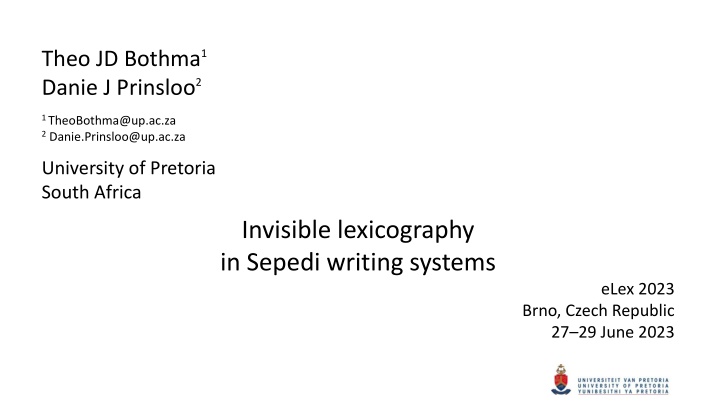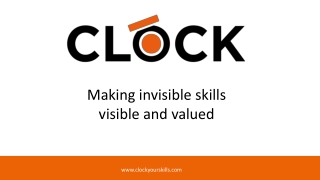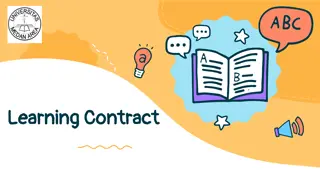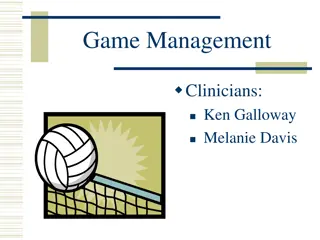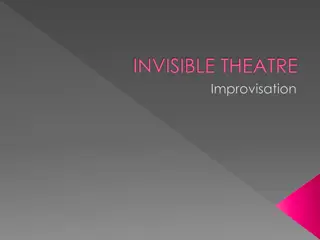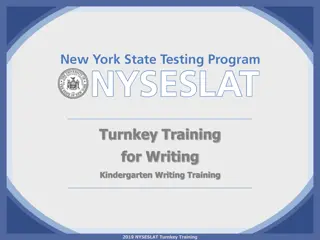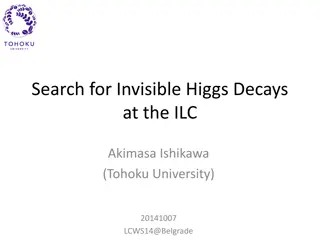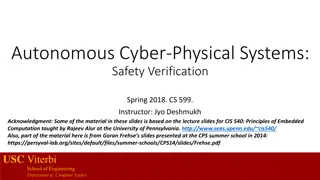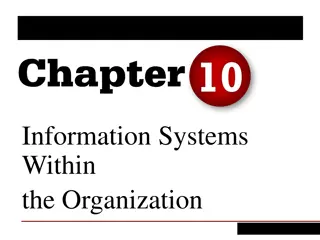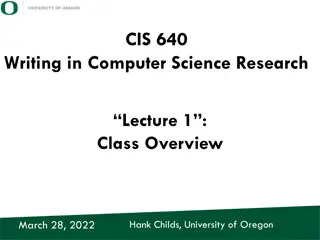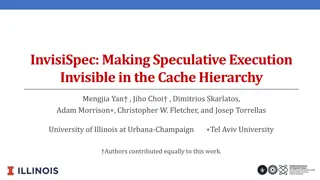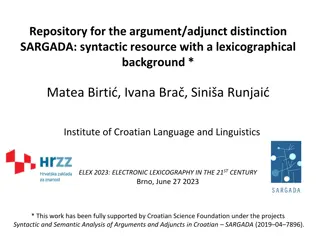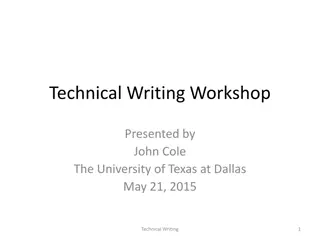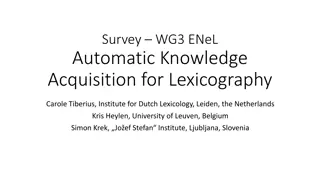Invisible Lexicography in Sepedi Writing Systems
Much research and development are being done on writing assistants for various languages. This paper focuses on two pioneering writing assistants developed for Sepedi, a lesser-resourced language of South Africa. The Sepedi Helper and the Copulative Decision Tree assist students in constructing sentences and navigating complex structures in Sepedi. These tools utilize invisible lexicographic strategies and offer different levels of grammatical explanations, functioning as valuable resources for learning the language.
Download Presentation

Please find below an Image/Link to download the presentation.
The content on the website is provided AS IS for your information and personal use only. It may not be sold, licensed, or shared on other websites without obtaining consent from the author.If you encounter any issues during the download, it is possible that the publisher has removed the file from their server.
You are allowed to download the files provided on this website for personal or commercial use, subject to the condition that they are used lawfully. All files are the property of their respective owners.
The content on the website is provided AS IS for your information and personal use only. It may not be sold, licensed, or shared on other websites without obtaining consent from the author.
E N D
Presentation Transcript
Theo JD Bothma1 Danie J Prinsloo2 1 TheoBothma@up.ac.za 2 Danie.Prinsloo@up.ac.za University of Pretoria South Africa Invisible lexicography in Sepedi writing systems eLex 2023 Brno, Czech Republic 27 29 June 2023
Overview Introduction Brief description of the Sepedi Helper and the Copulative Decision Tree Functionalities Screen shots Invisible lexicography underlying the two systems Possible extensions Conclusion
Introduction Much research and development is being done by numerous companies on writing assistants, e.g. Grammarly (https://www.grammarly.com/) Linguix (https://linguix.com/) Ginger (https://www.gingersoftware.com/) Most of these writings assistants work on text production in one language only Some provide assistance in multiple languages, e.g. LanguageTool, which provides assistance in more than twenty languages (https://languagetool.org/) Most assistants work in resource-rich languages
Current paper We describe some features of two pioneering writing assistants developed for Sepedi, a lesser-resourced language of South Africa, viz. The Sepedi Helper It provides access to constructing Sepedi sentences via Sepedi or English words, and makes use of a fairly basic translation dictionary The Copulative Decision Tree It enables the user to navigate the complex structures of copulative constructions in Sepedi User studies revealed that both these systems are very useful tools for students learning Sepedi
Basic characteristics In both cases, invisible lexicographic strategies played a major underlying role Both systems Help users to write grammatically correct Sepedi Provide different levels of drill-down options for limited or detailed grammatical explanations Therefore also function as computer-aided language learning tools (CALL) Are prototypes that can be developed further Information is available on demand, i.e., no information overload Current and future compilation of writing assistants for Sepedi should be inspired by these two successful efforts
Sepedi Helper functionalities in a nutshell The Sepedi Helper is intended as a step-by-step building assistant, aimed at complementing the existing knowledge of the user The core of the Sepedi Helper lies in the build-up facility where the user is prompted to provide a subject noun, a verb and optionally an object noun or nouns The software adds all the required concords, negation morphemes, correct verbal endings, etc. The main screen of the Sepedi Helper presents the layout and abilities of the program as a sentence builder in different moods, in all of the tenses as well as positive and negative forms It is a work in progress, the ultimate aim being the design and implementation of a complete electronic grammar for Sepedi, integrated into an interactive e-dictionary.
Purpose of the Sepedi Helper as a user support tool It combines user knowledge with production support, i.e., user- involved interactive text production of verbs in the different moods in Sepedi, as well as other constructions The tool functions as a confirmation mechanism: should users utilize their own knowledge in a production situation, the tool must be able to confirm the correctness of their efforts The tool must be able to assist users to identify mistakes and provide them with the necessary guidance to correct such errors
Copulative Decision Tree functionalities in a nutshell The copulative is the most complicated structure in Sepedi and a nightmare to conquer for students learning the language It is intended as a step-by-step guidance for the user through the complicated system leading them to the correct answer through a sequence of binary choices It navigates the user through the two main types of copulatives, via the three semantic relations, viz. identifying, descriptive and associative, through the different verbal moods, and finally through the nominal class system
Decision tree for 3rd person Sepedi static copulatives
Invisible lexicography In this paper, invisible lexicography is more broadly interpreted as including all lexicographically relevant aspects of a complex grammar typically catered for in a good dictionary for Sepedi Paper-based as front/back/middle matter Online also as pop-up information obtained through cursor hovering and clicking (drill-down)
Invisible lexicography This includes lexicographic guidance for user and programmer on translation equivalents the semantics of verbal moods morphology of the verbal moods nominal system syntactic order, and part of speech indication represented here as underlying/invisible part of speech markup copulative system
Translation equivalents
Semantics of verbal moods Click on Indicative provides a summary of the meaning of the different moods
Morphology of verbal moods Click on question mark provides a detailed description
Semantics and morphology of verbal moods
Nominal system Implementation result: Building possessive constructions User is prompted for a possessor noun (typed in English or the African language), e.g. puku User is prompted for a possession noun (typed in English or the African language) e.g. monna Tool provides the correct possessive concord: ya Result: puku ya monna, the book of the man
Part of speech indication represented here as underlying/invisible part of speech markup
Copulative hover over More data for user and programmer
Copulative summary and drill-down
Copulative explanatory summary plus further drill-down options
Copulative system (partial)
Extension - Verification The basic objective is reassurance to the users that the text they produced is correct The phrase produced is verified against a Sepedi corpus to ensure that concords and pronouns have been used and presented in the correct syntactic order, and that word division was done correctly The verification is attempted on different levels: The ideal is to find a perfect match, that is the identical phrase in the corpus preferably occurring several times If an exact match is not found, the system offers a variety of near- matches which could also serve as confirmation of correct text production
Verification example, Copulative Decision Tree Concordance lines: O tlo kgopela Satsope Re tlo bot i a Madika Ke mang Typical collocates: Motho yo a lego Mang yo a lego Yo a lego kgauswi yo a lego yo a lego yo a lego gona bohale kudu ofising ya mopresidente
Further research Both systems are prototypes, and should be further developed The current dictionary of the Sepedi Helper is limited in terms of both the number of words and semantic details in the word list It could not utilise any detailed grammatical and semantic descriptions Research should be done how more semantic details will be enriching Both systems should be integrated into a word processor for easy access CALL aspects should be further developed Further drill-down to more detailed descriptions or outer texts of dictionaries or grammars Possible advantages of AI should be investigated
Conclusion User studies revealed that students learning Sepedi find the Sepedi Helper a very useful tool Both systems are de facto computer-aided language learning systems, as users can learn by doing, and check their results Drill-down options for more detailed explanations Links to detailed descriptions or outer texts of dictionaries or grammars Information on demand and no information overload The usability of next generation Sepedi writing assistants depend to a very large extent on an enriched lexicographic database and further technological innovation
References Prinsloo, D.J., Heid, U., Bothma, T.J.D. & Faa , G. 2012. Interactive, dynamic electronic dictionaries for text production. Lexikos 22: 290-320. Prinsloo, D.J. 2002. The lemmatization of copulatives in Northern Sotho. Lexikos 12: 21-43. Prinsloo, D.J. 2020. User studies on the Sepedi Copulative Decision Tree. Southern African Linguistics and Applied Language Studies 38(4): 323-335. Prinsloo, D.J. & Bothma, T.J.D. 2020. A copulative decision tree as a writing tool for Sepedi. South African Journal of African languages 40:1: 85-97. Prinsloo, D.J. & Prinsloo, Daniel. 2021. A writing assistant en route to a full computational grammar for Sepedi. South African Journal of African Languages 41(1): 12-21. Prinsloo, D.J. & Taljard E. 2019. User studies on the Sepedi Helper writing assistant. Language Matters 50(2): 73-99. Prinsloo, D.J & van Graan, N.D. 2021. Principles and Practice of cross-referencing in paper and electronic dictionaries with specific reference to African languages. Lexicography 8(1): 32-58. . Sepedi Helper. nd. Available online at: http://www.sepedihelper.co.za/. Accessed June 11, 2023.
Thank you! Theo Bothma Theo.Bothma@up.ac.za Danie Prinsloo Danie.Prinsloo@up.ac.za
